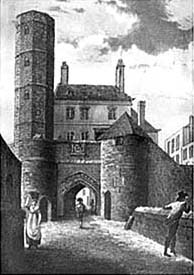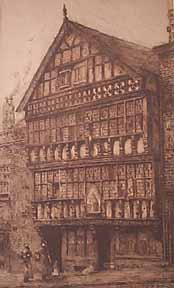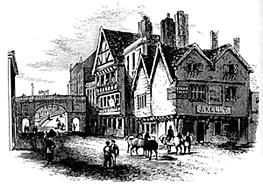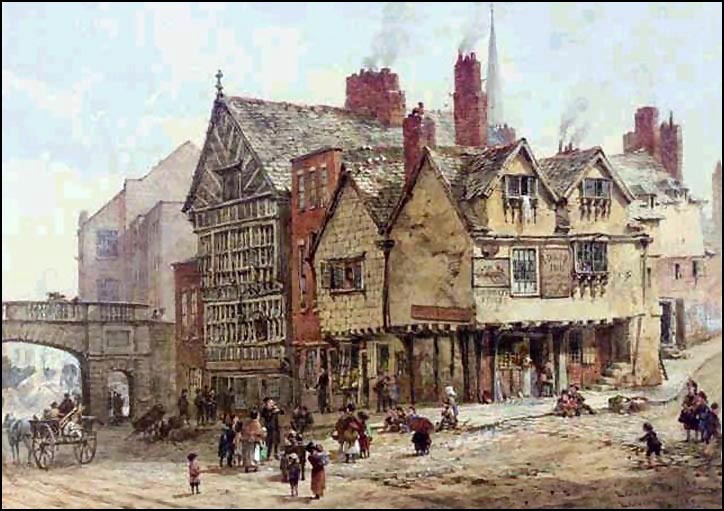This watercolour by Louise Rayner, executed in a 'looser' style than many of her works, depicts a scene that remains almost entirely familiar to modern Cestrians at the corner of Lower Bridge Street and Shipgate Street. Two ancient inns are featured- the Old Edgar and the Bear & Billet.
 The Gates of Chester, with the exception of the Northgate, which was the charge of the Mayor and citzens, were held in serjeancy, or wardenship, by noble families who were responsible for maintaining them so as to be ready as defences in times of war. In turn, they were allowed the lucrative privilege of charging tolls on all goods brought into the town through their gate. The Gates of Chester, with the exception of the Northgate, which was the charge of the Mayor and citzens, were held in serjeancy, or wardenship, by noble families who were responsible for maintaining them so as to be ready as defences in times of war. In turn, they were allowed the lucrative privilege of charging tolls on all goods brought into the town through their gate.
In the 17th century, the Bridgegate was in the charge of the Talbots, the Earls of Shrewsbury, who, when in Chester, resided in the splendid timber house long known as the Bear and Billet Inn. This Bridgegate, shown here in an engraving by George Batenham, was of major importance as it gave access to the Old Dee Bridge. Comprising a massive arched gateway with two strong towers on either side, it was sometimes known, because it guarded the only direct approach to Chester from Wales, as the Welshgate.
Actually, this ancient, heavily fortified entrance had been gone a century when Louise's painting was made, which features its modern replacement, an elegant archway with no defensive capabilities whatsoever, designed by Joseph Turner and erected in 1782.
Notice the large doors at the top of the Bear & Billet- the opening to the loft where goods were stored after being hoisted up from the street. This was common practice at the time, the loft being the part of a house deemed most secure from damp, vermin- and thieves. The windows on the first and second floors extend right across the front of the building and contain 1,620 quarries, or small leaded panes of glass- doubtlessly, during the 17th and 18th centuries, a serious drain upon the purses of the occupants during the bad old days of window taxes!
 It is unsure when the building first became an inn, though it is said that the Earls of Shrewsbury leased it to an innkeeper, on condition that a suite of rooms was always kept available for the Earl and his family. A drawing of 1820 shows it as the Bridgegate Tavern and is believed to have acquired its present name soon afterwards. It is unsure when the building first became an inn, though it is said that the Earls of Shrewsbury leased it to an innkeeper, on condition that a suite of rooms was always kept available for the Earl and his family. A drawing of 1820 shows it as the Bridgegate Tavern and is believed to have acquired its present name soon afterwards.
The pub's character changed greatly during modern times- when this writer first visited it in the early 1970s, it was a lively (to say the least) venue popular with the motorcycling fraternity. The passing years found it becoming increasingly neglected and scruffy until, in September 1999, it closed its doors as a public house and became a bistro and the new owners, in their wisdom, renamed the old pub- a decision that found little local support. However, some years later, the long-troubled Billet passed into the care of the Isle of Man based Okells Brewery and has thankfully once again become an excellent traditional pub offering decent food and a very wide choice of real ales and lagers from around the world.
Collectors of obscure Beatles information will be interested to know that John Lennon's (and his half-sister Julia Baird's) grandmother, Annie Jane Millward, was born in the Bear & Billet in 1873 and lived there until she was in her 20s. Julia, a longtime former Chester resident, recalled, "Our great-grandfather (John Denbry Millward) and great-grandmother (Mary Elizabeth Millward nee Morris) lived there. Our great-grandfather was the clerk to the Earl of Shrewsbury and because of that he had the freedom to the city of Chester. During childhood, John and I used to spend a lot of time in Chester. We also used to come on the train from Liverpool as we always knew that Chester was the best place for clothes shopping. We used to go for lunch at Brown's and walk down by the river. Chester has always been in the family. We are the classic family that moved from Wales to Chester to Liverpool. John was very fond of Chester. We always thought Chester was the place to be, not Liverpool".
Annie married George Ernest Stanley, had seven children (the first two died in infancy) - one of whom was John's mother Julia. She died in 1941.
 The ancient Bear & Billet may be thriving but many others have not been so fortunate- go here to learn about the many Chester pubs that have ceased to be. On the corner of Shipgate Street, and prominent in Louise's painting, is one such ancient tavern, the Old Edgar, dating from around 1500, which, after years of dereliction was restored and now serves as two private residences. It is named after King Edgar of England, who, according to legend, was rowed on the River Dee from his palace in what is now known as Edgar's Field, just across the bridge, to St. John's Church by eight subject kings in token of submission to him. The event was portrayed on a large painting which can be seen on the inn's wall. A splendid copy of this, translated onto ceramic wall tiles, is a proud feature in the George Street entrance to the Bull & Stirrup Hotel in Northgate Street. The ancient Bear & Billet may be thriving but many others have not been so fortunate- go here to learn about the many Chester pubs that have ceased to be. On the corner of Shipgate Street, and prominent in Louise's painting, is one such ancient tavern, the Old Edgar, dating from around 1500, which, after years of dereliction was restored and now serves as two private residences. It is named after King Edgar of England, who, according to legend, was rowed on the River Dee from his palace in what is now known as Edgar's Field, just across the bridge, to St. John's Church by eight subject kings in token of submission to him. The event was portrayed on a large painting which can be seen on the inn's wall. A splendid copy of this, translated onto ceramic wall tiles, is a proud feature in the George Street entrance to the Bull & Stirrup Hotel in Northgate Street.
A
1905 postcard advertised the Edgar Tavern, as it was then called, as offering "refreshment rooms and accomodation for cyclists".
An interesting feature of the painting is the presence, beyond the Bridgegate, of the Dee Mills, which stood here, in one form or other, from Norman times until the early 20th century. The site is now occupied by a hydro- electric generating station, which opened in 1913- the first of its kind in Britain and an early example of 'green energy'.. |

